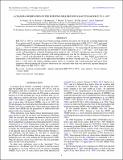| dc.contributor.author | Paizis, A. | |
| dc.contributor.author | Rodriguez, J. | |
| dc.contributor.author | Wilms, J. | |
| dc.contributor.author | Chaty, S. | |
| dc.contributor.author | Del Santo, M. | |
| dc.contributor.author | Ubertini, P. | |
| dc.contributor.author | Nowak, Michael A. | |
| dc.date.accessioned | 2015-02-20T19:00:48Z | |
| dc.date.available | 2015-02-20T19:00:48Z | |
| dc.date.issued | 2012-07 | |
| dc.date.submitted | 2012-02 | |
| dc.identifier.issn | 0004-637X | |
| dc.identifier.issn | 1538-4357 | |
| dc.identifier.uri | http://hdl.handle.net/1721.1/95462 | |
| dc.description.abstract | IGR J17511–3057 is a low-mass X-ray binary hosting a neutron star and is one of the few accreting millisecond X-ray pulsars with X-ray bursts. We report on a 20 ks Chandra grating observation of IGR J17511–3057, performed on 2009 September 22. We determine the most accurate X-ray position of IGR J17511–3057, α[subscript J2000] = 17[superscript h]51[superscript m]08[s over .]66, δ[subscript J2000] = –30°57'41['' over .]0 (90% uncertainty of 0['' over .]6). During the observation, a ~54 s long type-I X-ray burst is detected. The persistent (non-burst) emission has an absorbed 0.5-8 keV luminosity of 1.7 × 10[superscript 36] erg s[superscript –1] (at 6.9 kpc) and can be well described by a thermal Comptonization model of soft, ~0.6 keV, seed photons upscattered by a hot corona. The type-I X-ray burst spectrum, with average luminosity over the 54 s duration L [subscript 0.5-8 keV] = 1.6 × 10[superscript 37] erg s[superscript –1], can be well described by a blackbody with kT [subscript bb] ~ 1.6 keV and R [subscript bb] ~ 5 km. While an evolution in temperature of the blackbody can be appreciated throughout the burst (average peak kT [subscript bb] = 2.5[+0.8 over –0.4] keV to tail kT [subscript bb] = 1.3[+0.2 over –0.1] keV), the relative emitting surface shows no evolution. The overall persistent and type-I burst properties observed during the Chandra observation are consistent with what was previously reported during the 2009 outburst of IGR J17511–3057. | en_US |
| dc.language.iso | en_US | |
| dc.publisher | IOP Publishing | en_US |
| dc.relation.isversionof | http://dx.doi.org/10.1088/0004-637x/755/1/52 | en_US |
| dc.rights | Article is made available in accordance with the publisher's policy and may be subject to US copyright law. Please refer to the publisher's site for terms of use. | en_US |
| dc.source | American Astronomical Society | en_US |
| dc.title | A CHANDRA OBSERVATION OF THE BURSTING MILLISECOND X-RAY PULSAR IGR J17511–3057 | en_US |
| dc.type | Article | en_US |
| dc.identifier.citation | Paizis, A., M. A. Nowak, J. Rodriguez, J. Wilms, S. Chaty, M. Del Santo, and P. Ubertini. “A CHANDRA OBSERVATION OF THE BURSTING MILLISECOND X-RAY PULSAR IGR J17511–3057.” The Astrophysical Journal 755, no. 1 (July 25, 2012): 52. © 2012 The American Astronomical Society | en_US |
| dc.contributor.department | MIT Kavli Institute for Astrophysics and Space Research | en_US |
| dc.contributor.mitauthor | Nowak, Michael A. | en_US |
| dc.relation.journal | The Astrophysical Journal | en_US |
| dc.eprint.version | Final published version | en_US |
| dc.type.uri | http://purl.org/eprint/type/JournalArticle | en_US |
| eprint.status | http://purl.org/eprint/status/PeerReviewed | en_US |
| dspace.orderedauthors | Paizis, A.; Nowak, M. A.; Rodriguez, J.; Wilms, J.; Chaty, S.; Del Santo, M.; Ubertini, P. | en_US |
| mit.license | PUBLISHER_POLICY | en_US |
| mit.metadata.status | Complete | |
